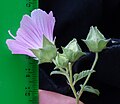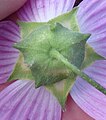
In botany, a bract is a modified or specialized leaf, especially one associated with a reproductive structure such as a flower, inflorescence axis or cone scale. Bracts are usually different from foliage leaves. They may be smaller, larger, or of a different color, shape, or texture. Typically, they also look different from the parts of the flower, such as the petals or sepals. A plant having bracts is referred to as bracteate or bracteolate, while one that lacks them is referred to as ebracteate and ebracteolate, without bracts.

Althaea officinalis, the marsh mallow or marshmallow, is a species of flowering plant indigenous to Europe, Western Asia and North Africa, which is used in herbalism and as an ornamental plant. A confection made from the root since ancient Egyptian times evolved into today's marshmallow treat, but most modern marshmallow treats no longer contain any marsh-mallow root.

Malva is a genus of herbaceous annual, biennial, and perennial plants in the family Malvaceae. It is one of several closely related genera in the family to bear the common English name mallow. The genus is widespread throughout the temperate, subtropical and tropical regions of Africa, Asia and Europe.

Hibiscus trionum, commonly called flower-of-an-hour, bladder hibiscus, bladder ketmia, bladder weed, puarangi and venice mallow, is an annual plant native to the Old World tropics and subtropics. It has spread throughout southern Europe both as a weed and cultivated as a garden plant. It has been introduced to the United States as an ornamental where it has become naturalized as a weed of cropland and vacant land, particularly on disturbed ground.

Malva moschata, the musk mallow or musk-mallow, is a species of flowering plant in the family Malvaceae, native to Europe and southwestern Asia, from Spain north to the British Isles and Poland, and east to southern Russia and Turkey. Growing to 60 cm (24 in) tall, it is a herbaceous perennial with hairy stems and foliage, and pink saucer-shaped flowers in summer.
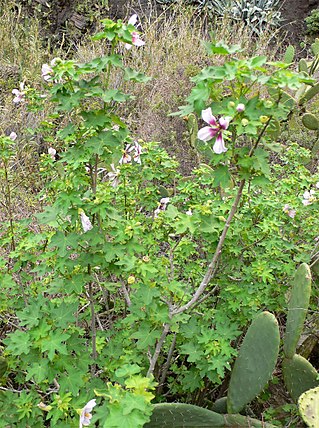
Malva acerifolia, also frequently known under the synonyms Lavatera acerifolia or Malva canariensis is a shrub endemic to the Canary Islands, belonging to the family Malvaceae.

Malva alcea is a plant in the mallow family native to southwestern, central and eastern Europe and southwestern Asia, from Spain north to southern Sweden and east to Russia and Turkey.
This page provides a glossary of plant morphology. Botanists and other biologists who study plant morphology use a number of different terms to classify and identify plant organs and parts that can be observed using no more than a handheld magnifying lens. This page provides help in understanding the numerous other pages describing plants by their various taxa. The accompanying page—Plant morphology—provides an overview of the science of the external form of plants. There is also an alphabetical list: Glossary of botanical terms. In contrast, this page deals with botanical terms in a systematic manner, with some illustrations, and organized by plant anatomy and function in plant physiology.
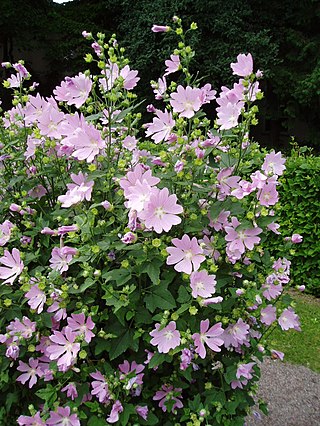
Malva thuringiaca, the garden tree-mallow, is a species of flowering plant in the mallow family Malvaceae, native to eastern Europe and southwestern Asia, from southern Germany south to Italy, and east to southern Russia, Kazakhstan, and Turkey.

Malva sylvestris is a species of the mallow genus Malva in the family of Malvaceae and is considered to be the type species for the genus. Known as common mallow to English-speaking Europeans, it acquired the common names of cheeses, high mallow and tall mallow as it migrated from its native home in Western Europe, North Africa and Asia through the English-speaking world.

Malva neglecta is a species of plant of the family Malvaceae, native to most of the Old World except sub-Saharan Africa. It is an annual growing to 0.6 m (2 ft). It is known as common mallow in the United States and also as buttonweed, cheeseplant, cheeseweed, dwarf mallow, and roundleaf mallow. This plant is often consumed as a food, with its leaves, stalks and seed all being considered edible. This is especially true of the seeds, which contain 21% protein and 15.2% fat.

Malva parviflora is an annual or perennial herb that is native to Northern Africa, Europe and Asia and is widely naturalised elsewhere. Common names include cheeseweed, cheeseweed mallow, Egyptian mallow, least mallow, little mallow, mallow, marshmallow, small-flowered mallow, small-flowered marshmallow and smallflower mallow. It typically grows on agricultural lands and in disturbed sites such as roadsides.

Malva multiflora is a species of flowering plant in the mallow family known by the common names Cornish mallow and Cretan hollyhock. It is native to western Europe, North Africa, and the Mediterranean Basin, and it is naturalized in areas with a Mediterranean climate, such as parts of Australia, South Africa, and California. This is an annual or biennial herb growing a tough, somewhat hairy stem to a maximum height between 1 and 3 meters. The leaves are multilobed with flat or wavy edges, slightly hairy, and up to 10 centimeters long. The plant bears small pink or light purple flowers with petals just over a centimeter long. The fruit is disc-shaped with 7 to 10 segments.
This glossary of botanical terms is a list of definitions of terms and concepts relevant to botany and plants in general. Terms of plant morphology are included here as well as at the more specific Glossary of plant morphology and Glossary of leaf morphology. For other related terms, see Glossary of phytopathology, Glossary of lichen terms, and List of Latin and Greek words commonly used in systematic names.
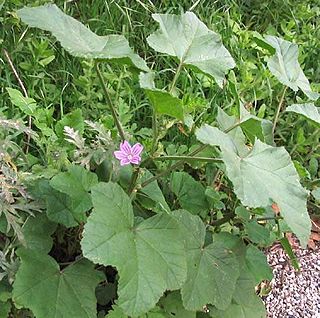
Malva nicaeensis is a species of flowering plant in the mallow family known by the common names bull mallow and French mallow.
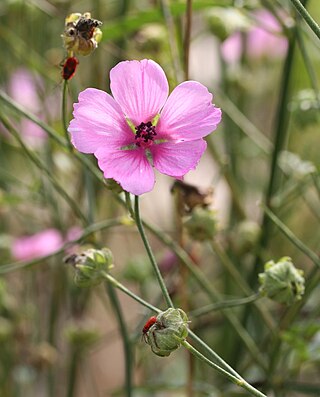
Althaea cannabina, commonly called palm-leaf marshmallow or hemp-leaved hollyhock, is a perennial herb belonging to the genus Althaea of the family Malvaceae. The leaves resemble those of hemp, hence the specific epithet cannabina ("hemp-like").

Malva verticillata, also known as the Chinese mallow or cluster mallow, is a species of the mallow genus Malva in the family of Malvaceae found in East Asia from Pakistan to China. M. verticillata is an annual or biennial that grow up to 1.7 meters in high and can inhabit woodland areas of different soil types. The small, symmetrical flowers have five white, pink or red petals (0.8 cm) and thirteen or more stamens. Each flower has three narrow epicalyx bracts. The fruit is a dry, hairless nutlet. The leaves are simple and alternate.
Malva pusilla, also known as Malva rotundifolia, the low mallow, small mallow, or the round-leaved mallow, is an annual and biennial herb species of the Mallow genus Malva in the family of Malvaceae. Malva is a genus that consists of about 30 species of plants. This genus consists of plants named mallows. Mallows grow in many regions, including temperate, subtropical, and tropical areas.

Malva hispanica, the Spanish mallow, is a species of flowering plant in the family Malvaceae, native to the western Mediterranean. Uniquely in its genus, Malva hispanica flowers possess a bilobed epicalyx, which is derived from an ancestral trimerous structure and represents a loss of the adaxial epicalyx lobe.

Althaea hirsuta, the hairy marshmallow, is a species of annual herb in the family Malvaceae. They have a self-supporting growth form and simple, broad leaves. Individuals can grow to 28 cm (11 in).








